Photo
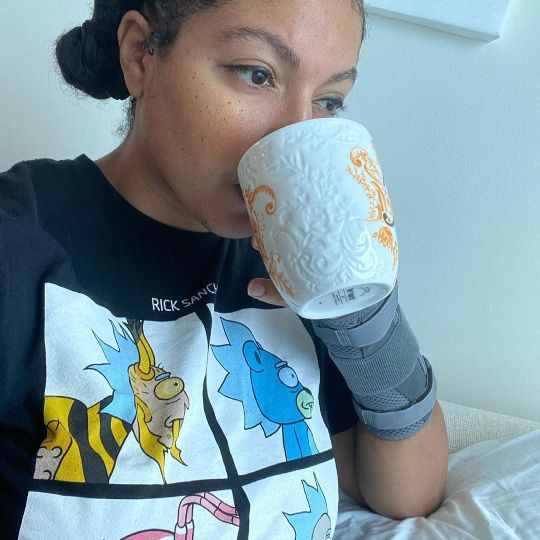
Putting some new stuff together with the BFF .. getting excited to share.. #blogger #blackgirlmagic https://www.instagram.com/p/CMkjmjxlfcX/?igshid=ghcaqp84n03o
0 notes
Photo

Lo fi... #lifestyle #blogger #consciousliving https://www.instagram.com/p/CIywWeKFa7m/?igshid=enqo363bks97
0 notes
Photo

...when investigating what was driving the price of colleges/ high student loan cost, one of the factors was the fact that college education has become a big business as opposed to a social necessity... check out my blog post on student loans to see more! #studentloans #consciouslifestyle #mindmusicspirit #blogger #consciouscapitalism #systemicdebt #studentloanforgiveness https://www.instagram.com/p/CIRbcqrFPYc/?igshid=1teg2nsaatafv
#studentloans#consciouslifestyle#mindmusicspirit#blogger#consciouscapitalism#systemicdebt#studentloanforgiveness
0 notes
Photo
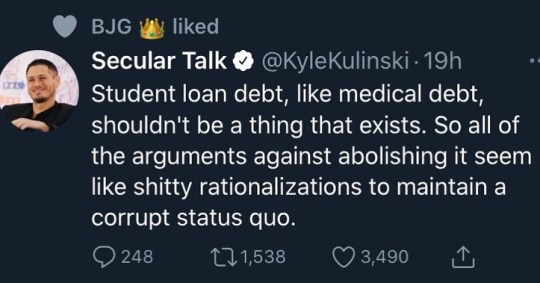
I’m inclined to agree . Check out my previous two blogs on student debt and medical debt to get a better idea at just how irrational these structures are, especially as other comparable countries outperformtye US in quality despite both their medical and education being universal. Systemic debt traps 😠😠 link in bio! #mindmusicspirit #studentloan #medical #medicaldebt #studentlomdebt #consciouslifestyle #blogger #mindfulliving #lifestyleblogger #lifestyleblog https://www.instagram.com/p/CHxmJGelF7t/?igshid=424n4cwrohg
#mindmusicspirit#studentloan#medical#medicaldebt#studentlomdebt#consciouslifestyle#blogger#mindfulliving#lifestyleblogger#lifestyleblog
0 notes
Photo
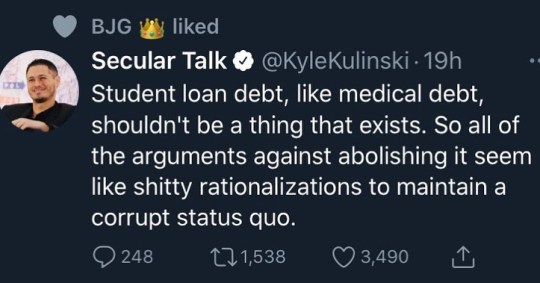
I’m inclined to agree . Check out my previous two blogs on student debt and medical debt to get a better idea at just how irrational these structures are, especially as other comparable countries outperformtye US in quality despite both their medical and education being universal. Systemic debt traps 😠😠 link in bio! #mindmusicspirit #studentloan #medical #medicaldebt #studentlomdebt #consciouslifestyle #blogger #mindfulliving #lifestyleblogger #lifestyleblog https://www.instagram.com/p/CHxmJGelF7t/?igshid=424n4cwrohg
#mindmusicspirit#studentloan#medical#medicaldebt#studentlomdebt#consciouslifestyle#blogger#mindfulliving#lifestyleblogger#lifestyleblog
0 notes
Photo
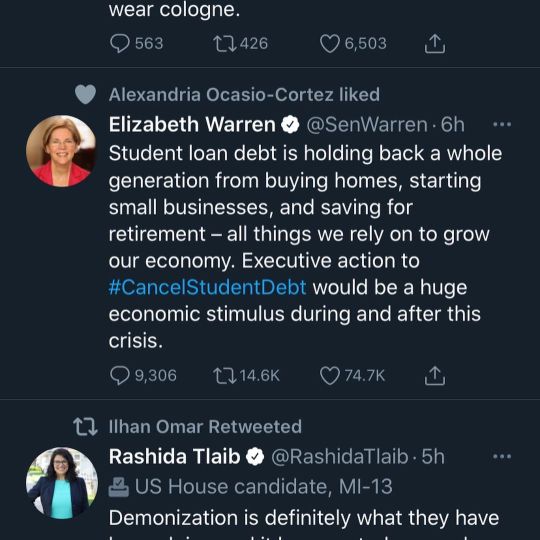
Recent activity on Twitter sees many people calling on for the cancellation of student debt, as the total accumulated debt has reached 1.7 trillion dollars! Check out my blog on student debt to find out how this hinders economic development and progress among so much more! #cancelstudentloandebt #consciouslifestyle #consciousliving #mindmusicspirit #studentloans #millennials #blogger https://www.instagram.com/p/CHvcVxLFbtY/?igshid=107d44hxvpshp
#cancelstudentloandebt#consciouslifestyle#consciousliving#mindmusicspirit#studentloans#millennials#blogger
0 notes
Photo

🤣🤣🤣 I should have recorded the actual video ... check out my latest blog post (link in bio) on student loans and see what else, besides predatory interest loans, is driving up the cost of college/higher education #studentloans #mindmusicspirit #blog #consciousconsumerism #consciouscapitalism #lifestyleblog https://www.instagram.com/p/CE9Vht0FwD1/?igshid=8zmgvbcxi49p
0 notes
Photo
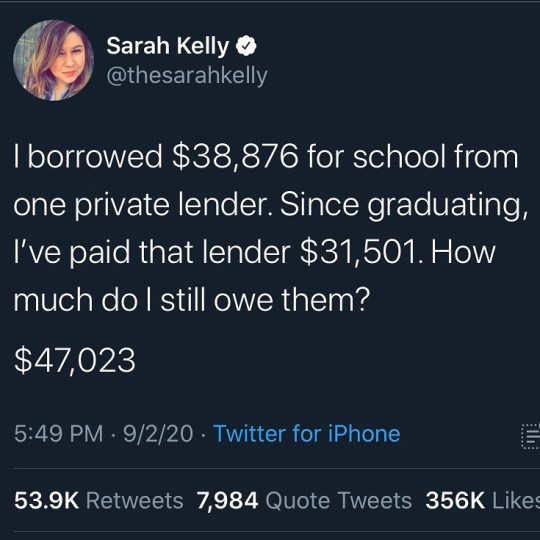
This $38k is roughly the average amount for student loan debt : the predatory loan interest rates, what else is contributing to such high college costs? Check out the latest post on my blog to find out! Link in bio 🙃🙃🙃#systemicdebt #studentloans #mindmusicspirit #collegeproblems #education #fundeducation https://www.instagram.com/p/CE4PHhOlRr-/?igshid=ug4rzp1m8ufe
0 notes
Photo

One of the reasons college eduction costs are so high is due to the defunding of eduction, especially secondary/higher eduction. That leaves the burden on the student and leaving us in debt from already predatory student loans. Check out my latest post on mindmusicspirit.com on one of the systemic debt traps that is student loans... 😰😰 #studentloans #fundeducation #mindmusicspirit #collegeloans #debt #consciouscapitalism #blog #lifestyleblogs #debttrap https://www.instagram.com/p/CEz6y1qlZS3/?igshid=m7752eg8ahk0
#studentloans#fundeducation#mindmusicspirit#collegeloans#debt#consciouscapitalism#blog#lifestyleblogs#debttrap
0 notes
Photo
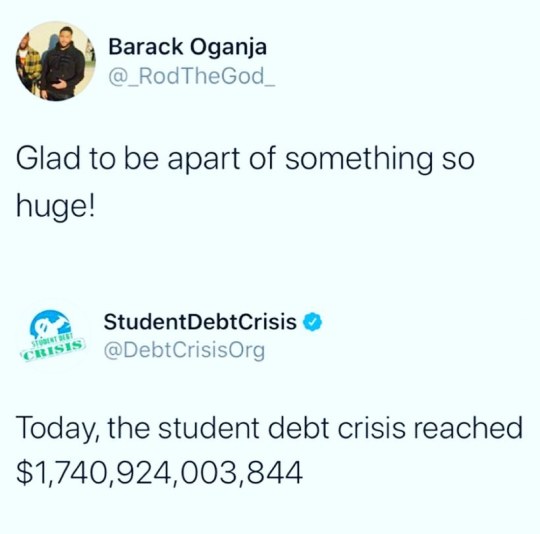
😣😣at the time I started writing this final installment for my systemic debt trap series, the total was $1.5 trillion ... check out my link in the bio now to see what’s been driving student loans and education costs, and the systemic reasons to why they’re high and what that means for us! #consciouscapitalism #studentloans #mindmusicspirit #debt #loandebt https://www.instagram.com/p/CEuR1JzFJpK/?igshid=128hacj5e94b4
0 notes
Text
Student Loans... enough said...
0 notes
Photo
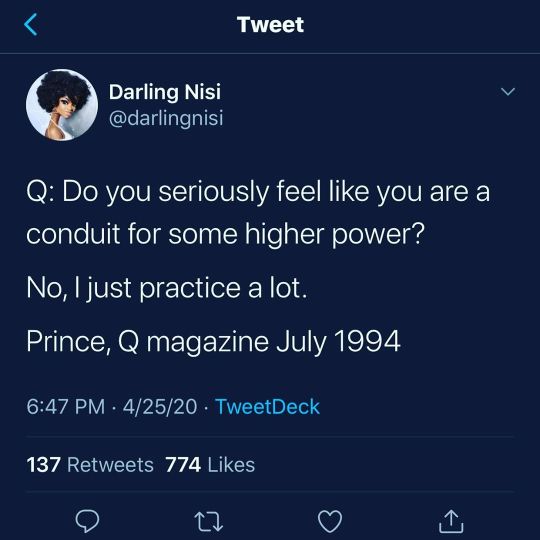
Saw this and it made me feel good...Inspiration if you’re like me and in the beginning steps of learning/mastering something new ...also 🙃🙃🙃 Check out my latest blog on medical debt. While it’s been a few months in the making, it’s quite relevant for what we’re going through right now. Link in bio! #itsnowmywallpaper #mindmusicspirit #blackblogger #lifestyle #consciouscapitalism #inspiration #medicine #medicalcare https://www.instagram.com/p/B_gZn05ljFN/?igshid=vn3m0ixl1dha
#itsnowmywallpaper#mindmusicspirit#blackblogger#lifestyle#consciouscapitalism#inspiration#medicine#medicalcare
0 notes
Photo

Had to get routine lab work done yesterday... did you know that 64% of people with medical debt problems had debt that started out with lab fees!?! Click link in bio to read my piece on Medical Debt #finance #lifestyle #consciouscapitalism #mindmusicspirit #blog #medical https://www.instagram.com/p/B_a7FUEFuGa/?igshid=1tigqfz0dp8h5
0 notes
Photo

Went on a walk around the neighborhood... with the quarantine and as someone who grew up/lived in apartments, I’ve been feeling guilty for the space of the suburbs lately. Hope everyone is staying safe regardless ❤️❤️ https://www.instagram.com/p/B_VqL89lP5i/?igshid=fpfshn365v09
0 notes
Photo

Old selfie... new post!! Check out my second feature in a three part series on what I like to call the systemic debt trap in the US: “Sick, Tired and Broke” where I explore what health experts call the “irrational” healthcare market, and how it affects our wallets and quality of life, especially for us millennials! Link in bio! #millenials #lifestyle #finance #healthcare #mindmusicspirit #intheknow https://www.instagram.com/p/B_Q_4m8lh-j/?igshid=16sj54z0nvwng
0 notes
Text
Sick, tired and broke...
While it took the coronavirus to get people to genuinely realise this : our healthcare system is trash when it truly doesn’t have to be.
That technically feels like the end of my Ted talk, but I’ll go into some slightly repetitive data about it, because what I ultimately discovered is that this healthcare system is costing the most financially and humanely for Millenials.
Let’s start out with 2019 when 137 million Americans faced financial hardship due to medical costs. Scary part is, regardless of age, high healthcare bills are the number one reason people would consider taking money out of their retirement accounts or filing for bankruptcy, while 66.5% of all personal bankruptcies are tied to medical issues. ( CNBC).
According to the NYTimes, Americans borrowed $88 billion in 2018 in order to pay for their healthcare. If we’re borrowing $88 billion to pay for healthcare, imagine the profit that these healthcare companies are enjoying!
Why is healthcare so expensive? The best answer I could find is due to a “free” market and lack of regulation by our government as well as a lack of transparency when it comes to medical billing. According to Public Health Policy Professor Marty Makary of John Hopkins, the healthcare marketplace is “irrational”-- though I prefer the term uncontrolled-- where price gouging has become the norm. Heart surgery at one hospital may cost $44,000 while the same surgery will cost $500K at another facility, and the kicker here is, despite the disparity in price, there is no marked difference between the quality of care in the different facilities (CNBC).
As for lack of transparency for medical billing, I can personally attest to that ( though clearly I’m not a unique case). Last year I was hospitalized at Tulane University Medical for Diabetic Ketoacidosis, brought on by food poisoning, and I received 3 seperate bills for that one stay. One bill was about $350, the second bill was for $2200 , and the third bill was for $14.99 with no thorough explanation about what I was being billed for ( no general explanation provided either). The bills were just medical coding with no legend of what the coding represented, leaving me angry and confused. How does one hospital stay, at one facility come with 3 seperate bills? Sad thing is, I had health insurance, and seeing as health insurance comes with deductibles and out of pocket limits, I figured those hospital bills hit that, at the very least. Apparently it did not for reasons not even the health insurance reps could explain to me. How do I spend $2500 out of pocket, when my limit is $1500, and you’re telling me that that $2500 doesn't count toward my out of pocket? A clear lack of transparency in not just medical billing, but health insurance as well.
The general high cost of medical care is another reason we’re just out here remaining sick and in debt: The average hospital stay in the US costs about $5220 per day, whereas in Australia where the nation's wealth is comparable to the US, it’s about $765 per day. It is not even hospital stays that are the initial causes/starting causes of medical debt either: 65% of medical debt started out with either diagnostic testing or a doctor’s visit followed by Lab fees, ER visits, drug prescription costs and outpatient services (SingleCare.com). Why would something/someone whose job it is to cure or heal you be what brings you into debt? Even more so, why does something as primary and preliminary such as diagnostic testing or seeing the doctor be the main cause of medical debt? We’re in debt before we can even know what’s ailing us? Drug prescriptions are no different either. About a month and a half ago I lost insulin vials and needed to get replacement vials from the pharmacy: I’ve never actually lost insulin before in my twenty years as a diabetic, so you think that my pristine record would count for something. It didn't. Health insurance was not going to cover it, and the cost of one vial was going to be $900. Keep in mind, one vial will last me about two weeks. Maybe three if I make sure to not eat. $900 is more than my half of rent to put that cost into perspective relative to my monthly bills, and it was only going to last me half the month. If prescription costs are that drastic, I can only imagine the average cost of the diagnostic or doctors visit that affect the 65% that fall into debt because of it.
In addition to costing us financially, high medical care and medical costs affect our quality of life and ability to accumulate wealth, especially Millennials. According to a 2016 study published by Health Affairs, Millennials carry the most medical debt in the US as well as incur it more frequently: the article focused more on the fact that the debt starts at the age of 27 once the medical care/insurance for young adults under their parents insurance ends at age 26. The age group that ended up accumulating the most debt was also age 27 ( PBS.org) The Millenial age group also accounts for 35% of the overall population, so that could be another reason why we hold the most medical debt as well ( Single Care).
Quality of life is also affected in that Americans are foregoing medical treatment or medical visits due to cost. In fact, 21% of Americans had to do that in 2016 alone. That is 21% of people not getting the necessary healing treatment they need, or living in the dark of what’s ailing them.
32% have postponed medical care due to cost. When I hear “postpone”, I assume that the only reason they end up getting medical care is because their ailment got worse or to a point where they couldn’t avoid not getting the medical care that they needed.
40% of adults ages 18-64 have relied on at home remedies or over the counter drugs instead of going to the doctor due to medical cost ( Singlecare.org)
I have fallen into all 3 categories: In fact, once , in order to avoid a hospital visit, I treated my own onset of ketoacidosis. For those of you not sure what that entails, it basically includes taking my insulin through my veins as opposed to subcutaneously ( injecting my arm or stomach) while avoiding any liquids or food, including water for at least 24 hours. The reason you have to do that is because your body’s acid level is falling to a dangerous level so it won’t react to insulin being delivered into your fat stores or beneath the skin: It has to be delivered directly to your bloodstream to have an effect. This acidity level will also cause your blood sugar to rise to dangerous levels, and potentially even lead to a heart attack if not treated in a timely manner.The low acidity level is also why the body won’t tolerate any food or liquid, as it tries to purge every possible foreigner from the body in order to normalize its pH level. Imagine not being able to drink water without violently vomiting it up. So there I was at home, a young twenty year old, injecting insulin into my veins, every hour for at least twenty four hours, until my body was on the mend again. I had to be my own doctor in order to avoid a $2k-$3k plus bill that I knew I couldn’t afford. Was it risky? Yes. But, I was forced to be concerned not only for my life but for my financial well being simultaneously. Sad fact of the matter is, I’m confident that I’m not the only type 1 diabetic with a story like that, and I’m not the first to have to weigh my life versus my finances.
In order to pay for medical costs:
53% work out payment plans with their provider. That’s probably the best option, although it ends up being one more bill to add to the list at the end of the month. I’m still paying off that $2500 hospital bill I previously mentioned.
37% have had to borrow money from family or friends
34% have increased their credit card debt
70% say they cut back spending on food, clothing, or other basic household items.
41% say they took an extra job or worked more hours.
59% say they used up most or all of their savings.
35% say they have been unable to pay for basic necessities like food, heat, or housing. (Singlecare.org)
The statistics at the bottom are exceptionally high and staggering. 70% have to cut back on basic household items/comforts in order to pay medical bills: Is it really a succesful or efficient healthcare system if you have to choose between food or medicine?
In addition to our quality of life/quality of health being impacted, I mentioned our ability to accumulate wealth, which for Millenials have proven more difficult than prior generations: According to Caroline Ratcliffe, a senior fellow at the Urban Institute who studies asset building and poverty, wealth is stagnating for younger generations compared to their parents and grandparents. For people under 40 years old: their wealth has only inched up compared to their parents in the 1980’s, and many factors affect that: Credit cards ( see prior posted article on credit card debt), Student loans ( future article) and of course medical debt:
When one in six Americans have past due medical bills on their credit report, it affects their ability to secure a good interest rate on a home or auto loan. ( PBS.org) We’re constantly told how real estate is one of the best ways to accumulate wealth, yet these unnecessary and predatory forms of debt make it harder for us to do so. A lot of these past due bills average about $600(CNBC), but when most of us have credit card bills, monthly living expenses, student loans, and living paycheck to paycheck, how easy is it to pay $600, realistically?
The additional injury to injury ( because we’re long past insults to injury), is the fact that medical care is slated to become even more expensive. It’s expected to hit $6 trillion by year 2027, and it’s already 2020!
When individuals, the federal and state government, and private business seem to share an equal balance of overall medical expenditures ( be it through medicare, the cost of employee covered insurance etc etc), why then would medical costs go up?
It goes back to the beginning of the article, where we pointed out how unchecked the healthcare industry is. Despite the fancy words and round about explanations we may get from lobbyists and those in healthcare, in addition to being gaslit by them that rising costs are unavoidable, it most certainly is avoidable.
Don't forget, compared to other countries that have comparable wealth to us, everything is more expensive here in the US, and there doesn’t seem to be a disparity in the actual quality of care. For example, the total health spending per capita is 84.8% more expensive in the US than in Canada.
In America, they perform 322 C-sections for every 1000 live births, which average a cost of $16,000. In the UK, it’s 264 C-sections per 1000 live births with an average cost of $6k.
An MRI averages about $1115 in America, yet averages to about $215 in Australia. (Singlecare.com).
These countries are comparable in wealth to us, so is affordable and universal health care really that far fetched or radical of an idea in America? Especially when it’s driving such a staggering amount of people into debt? The answer is NO. Based on the medical cost and quality in other countries, not only is it possible, but easy to make it affordable and universal. There are so many different models that are currently working that we can choose from to emulate even.
Health insurance, healthcare and pharmaceutical companies need to be governed or regulated here in the US. Otherwise, the health care system is just another player in the systemic debt traps that seem to be set for the poorer masses, and it’s a problem that’s only projected to get worse, especially for Millenials. It’s grossly affecting our overall quality of life and ability to generate wealth. These statistics show that while the sick get sicker and entrapped by debt, the healthcare industry and those at the top will benefit the most financially from our plight. This current system is neither logical, nor sustainable for the masses, the greater good, or for the economy.
What ever happened to the Hippocratic oath to do no harm?
References:
137 Million Americans are struggling with medical debt. Here’s what to know if you need some relief.
https://www.cnbc.com/2019/11/10/americans-are-drowning-in-medical-debt-what-to-know-if-you-need-help.html
2020 Medical Debt Statistics
https://www.singlecare.com/blog/medical-debt-statistics/
Millennials rack up the most Medical Debt and most frequently.
https://www.pbs.org/newshour/health/millennials-rack-up-the-most-medical-debt-and-more-frequently
Americans borrowed $88 billion to pay for healthcare last year, survey finds
https://www.nytimes.com/2019/04/02/health/americans-health-care-debt-borrowing.html
Survey: 79
million Americans have problems with Medical Bills or debt.
https://www.commonwealthfund.org/publications/newsletter-article/survey-79-million-americans-have-problems-medical-bills-or-debt
1 note
·
View note